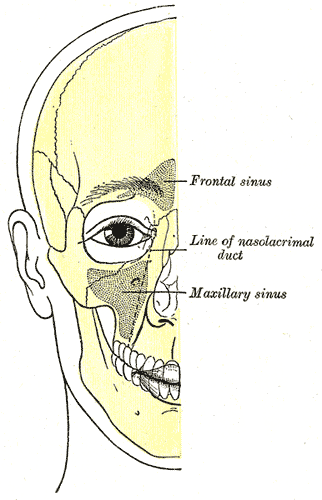Everybody will experience dental pain of some sort at some point in their life. When pain occurs at the region around your cheeks, you could bet that it is most likely due to some dental problems; or perhaps probably some gum related disease. However, it does not necessarily mean that teeth/gums problems are always the cause of pain in the cheek region, thus in this article, we’ll discuss about one of the possible indirect cause of toothache – through sinus infection.
The Sinus
When the term “sinus†is generally used, it is referring to the paranasal sinuses (para = beside, nasal = nose, sinus = empty space). Of all the 4 major paranasal sinuses, Maxillary sinus is the sinus that concerns us when there is occurrence of toothache related to sinus infection.
Maxillary sinus is the cavity or empty space which exists naturally behind our cheek bones, and just above the root of the upper molar teeth. At times, the root of the upper first molar can grow into the sinus, which causes difficulty should the teeth needs to be removed. Its function is to reduce the weight of our skull and to create a space to generate resonance of our voice when we speak. It has a tunnel which connects to the deeper part of the nose for fluid drainage. Obstruction of this connection will cause nasal congestion, resulting in difficulty in breathing.
Sinusitis is the term used when there is infection of the sinus. It can be either caused by introduction of foreign bacteria; or due to obstruction of the sinus.
Introduction of foreign bacteria
This can occur when there is exposure of the sinus due to cranial fracture caused by trauma; or oral-antral fistula which can occur during the extraction of an upper molar tooth, meaning an abnormal communication is established between the sinus and the oral cavity. Introduction of foreign bacteria into the sinus causes infection, in return promotes the secretion of thickened mucous which would ultimately lead to obstruction of the sinus opening.
Obstruction of the sinus opening
Failure for secreted mucous to drain from the sinus to the nasal cavity causes fluid to retain in the maxillary sinus. This promotes bacteria multiplication in the obstructed sinus which would invade the skin and cause localized sinus infection.
Sinus infection – Toothache
Okay, at this point, we’ve discussed the location of the maxillary sinus, and also the mechanism of how the sinus gets infected. But how does it relate to toothache? The answer is actually fairly straightforward: The nerve fibers of the upper back teeth emerges from the roots of the tooth, passes by the maxillary sinus (underneath the skin which covers the sinus), and makes its way to the outer part of the brain which is able to sense pain.
In other words, the infection of the skin in the maxillary sinus stimulates the nerve which supplies the upper back teeth, in return provides a false signal to the brain informing that there is pain when actually in fact the tooth is sound and healthy.
Some key points to look out to help you determine if the toothache is caused my sinus infection:
- Skin over sinuses involved maybe tender and swollen if there is sinusitis.
- Maxillary sinusitis may stimulate toothache, which unlike uncomplicated toothache, may vary with posture (the pain of sinusitis often being a pressure-dependant closed box type of pain).
- Predominantly in maxillary sinusitis, there may be inflamed nasal mucosa and purulent discharge.
- Sinusitis often presents with headache, general malaise and possibly fever.
- Diagnosis can be arrived by exclusion – toothache still persistent after healing of sinus infection.
Cure for Sinus infections
Antibiotics and nasal decongestants are normally prescribed to cure common sinus infections.
Please do not attempt on self diagnosing and buying your local drug store’s supply of clove oil should there be any toothache or facial pain. It is recommended to seek your local dentist for professional advice.
